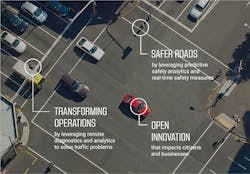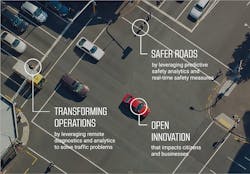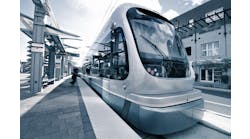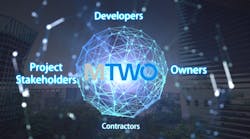By: Kurtis McBride
Everyone knows about the hard times that hit Detroit a few years ago. The auto industry was struggling. The local economy collapsed. The housing market imploded, and homes were selling for a couple thousand dollars at auction. Crime was out of control because there were not enough police to keep order. The city did not have enough money to maintain basic services and had to file for bankruptcy.
There is no sugarcoating it; things were bad. Fortunately, those rough times were only temporary. Today, Detroit is coming back strong. In fact, in a lot of ways, the downturn left the city in better shape to grow more quickly when the economy rebounded.
The story of Detroit is no longer a tragedy. It is one of resilience and perseverance. It is one of a city emerging from hard times to reach new heights. It started with modernizing traffic signals and resulted in a showcase of the world’s smartest intersections. And Detroit is well on its way to achieving its vision of becoming a smart city.
In a lot of ways, Detroit’s traffic infrastructure is a microcosm of the city’s larger story. A few years ago, no one would have looked to the city’s traffic signals and thought about the future. The traffic network was plagued by aging infrastructure, failing systems, and a shortage of funding and resources. Rolling brownouts plagued the city, which sometimes knocked out traffic lights. The signal system was so bad, transportation managers would not have known if lights around town were even working unless they went out and looked at them—or an angry resident called to complain, which happened far too often.
Outdated, unconnected infrastructure was a big part of the problem, along with a lack of data and tools for city staff to make good decisions about how to manage traffic flows. What little budget the city had for traffic was going toward maintaining existing signals.
The situation was creating safety risks for drivers and pedestrians on the roadways. Without a modern network supporting the traffic infrastructure, the city struggled to address bigger problems such as emergency response times or public transit reliability.
When Sunny Jacob, head of traffic operations in Detroit, began to tackle the problems, he started with a simple first question: What technology can we use to know if our signals are on, off or in flash?
Although the question seemed simple, the solution was not straightforward. The city needed a way to monitor signals remotely, but fewer than 20% of Detroit’s signals were connected to a network. They had very few in-ground fiber-optic lines to leverage so there was not even a complete network to connect the signals to. To make matters worse, Detroit’s signals were not just outdated, they had a range of different controller and cabinet types installed around the city, and they were not all compatible.
Even if they were able to connect the signals and start pulling data from them, the various systems were proprietary and closed, so the data could not be integrated. Not to mention, Detroit did not have a database and portal to store, view and generate alerts. The city did not have much of an IT budget or the expertise to build it all themselves. Detroit needed help.
After an extensive search, Jacob’s department tapped smart traffic technology company Miovision to modernize the system. Miovision installed TrafficLink units at 40% of the city’s intersections (with more to come), connecting the signals to a cellular network and installing cameras so they could be monitored from the traffic operations office. The cameras converted vehicle traffic to data so that Jacob’s team could know how many vehicles were passing through each intersection and how well, or poorly, traffic was flowing throughout the city. They started using the data to adjust signal timing to help traffic move more smoothly.
“We immediately saw significant improvements in traffic flow,” said Jacob. “Understanding where signal timing could be improved reduced travel times by more than 30% where the technology was deployed.”
Other city departments took advantage of the system as well. As such, Detroit Public Safety was able to integrate existing emergency vehicle tracking units with traffic lights to ensure that the vehicles were given green lights.
Miovision collaborated with Detroit traffic officials to create the “World’s Smartest Intersection.”
Expanding to the ‘World’s Smartest Intersection’
While Detroit was reaping immediate rewards from the newly connected traffic signals, the traffic operations team also started working with Miovision to experiment with more innovative ways to use the technology to advance more futuristic smart city goals that would make the city safer and more efficient for the people who live there. The result of this close collaboration with Jacob, his team and high-ranking city officials is the “World’s Smartest Intersection,” a system of sensors, video-based detection, connected traffic signals and remote monitoring capabilities at five intersections along the busy Larned Street corridor in the heart of Detroit.
To be clear, the World’s Smartest Intersection is not one app or a few features. It is not even one intersection. It is a collection of Miovision’s latest thinking and engineering in place, and its applications vary. It can create freight signal priority to help semi-trucks move more quickly through the city and avoid high-traffic areas. It uses pedestrian and cyclist traffic analytics to make streets safer for those vulnerable groups. It analyzes crash data to help achieve Vision Zero, a goal to eliminate deaths and serious injuries involving road traffic.
Through a combination of hardware and software based on open architecture and artificial intelligence, the World’s Smartest Intersection prioritizes citizen safety, communicates with surrounding traffic and infrastructure, and completely transforms the way traffic engineering teams operate.
The intersections are able to sense and understand what is happening on the roadways in real time and trigger responses, such as:
- Traffic lights that can extend green lights to accommodate cyclists who would not otherwise be able to make it through the intersection;
- Alerts that warn drivers of connected cars or Waze users that jaywalkers are ahead;
- Traffic lights that provide priority access to emergency vehicles;
- Intersections that understand and analyze the near misses between pedestrians, cyclists and drivers; and
- Traffic lights that allow for freight vehicles to have green-light priority, encouraging freight use on certain intersections away from pedestrian-heavy corridors.
“This corridor is a great example of how cities can leverage existing infrastructure to build innovative solutions that immediately benefit people,” said Mark de la Vergne, Detroit’s chief of mobility innovation. “We started with the goal of improving how we monitor our traffic signals, and now we’re working with Miovision to explore how to improve safety for pedestrians and help first responders get to emergencies more quickly.”
Improving safety a top priority
One of the most significant ways smart intersections can improve safety is by collecting different data to get a better picture of what causes crashes and dangerous intersections. Typically, cities study crash data to identify dangerous intersections, but crash data tends to regress to the mean year over year, so the number of collisions will naturally increase and decrease. A decrease one year does not necessarily mean safety has improved. That means it can take years to collect enough information to lead to changes. Meanwhile injuries and fatalities can continue to occur.
In reality, for every crash, there are hundreds of near misses. With video data from smart intersections, cities can study near misses and reveal much more much faster than they can with crash data. They can identify the most dangerous times of day and see how much external factors such as weather conditions contribute to crashes.
Also, Miovision’s proactive pedestrian safety analytics measure how pedestrians use intersections, giving cities information to help make street crossings safer by addressing dangerous situations before they happen. The technology’s sensors can even detect cyclists going through an intersection and extend green lights so they make it through before the signal changes.
Miovision installed TrafficLink units at 40% of the city’s intersections for traffic monitoring.
Open platform encourages innovation
One of the biggest differentiators between Miovision’s TrafficLink platform and other traffic-signal technology is that it is built on open architecture. That enables the city and other organizations to create innovative solutions to various traffic problems.
With the open platform, Detroit can expand its smart city ecosystem piece by piece, for example, starting with improving traffic flow and then expanding to freight signal priority (FSP) or emergency vehicle pre-emption (EVP).
In partnership with another company called Geotab, Miovision and the city implement an FSP system via API that leveraged the existing infrastructure and hardware within semi-trucks to help them find better routes through and around the city.
Miovision and the police department partnered to implement an EVP that uses GPS, existing transponders in police vehicles and TrafficLink to get police cars through intersections faster. In early testing along the Larned Street corridor, emergency response times dropped nearly 20% with no additional hardware cost to taxpayers. They also built a police portal that enables police to tap into real-time and historical video footage from the smart intersections to help with investigations.
Traditional traffic-signal systems are closed and proprietary, making it difficult or impossible for cities—let alone independent organizations—to take advantage of the hardware, software and data to create new solutions. In addition to creating these opportunities now, open architecture also future-proofs the infrastructure because it will be able to integrate with new technology that gets added later. Detroit will have more options to choose technologies that best fit its needs without having to worry about the traditional constraints of vendor lock-in.
The early results of Detroit’s smart intersections have been nothing short of incredible, and they are still in the earliest stages. Other cities and industry watchers have taken notice. In May, Detroit won an IDC Smart City North America Award for its smart intersections.
The irony of this story is that while other major cities were turning to giant corporations for expensive top-down smart city technologies, Detroit could not afford to. As the city’s budget began to improve, new solutions offered more flexible ways to get started. Meanwhile, those other cities are locked into systems that stifle innovation. Detroit, on the other hand, is now poised to show them all how it should be done.
About The Author: McBride is CEO of Miovision.





